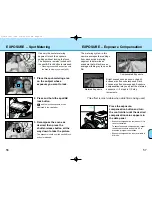
85
84
CARE AND STORAGE
Questions and Service
• If you have questions about your camera, contact your local
camera dealer or write to the Minolta distributor in your area.
• Before shipping your camera for repair, please contact an
authorized Minolta Service Facility for details.
Cleaning
• If the camera or lens barrel is dirty, wipe it gently with a soft,
clean, dry cloth.
If the camera or lens comes in contact with sand, gently blow
away loose particles - wiping may scratch the surface.
• To clean the lens surface, first brush away any dust or sand then,
if necessary, moisten a lens tissue with lens cleaning fluid and
gently wipe the lens in a circular motion, starting from the center.
• Never place lens fluid directly on the lens.
• Never touch the interior of the camera, especially the shutter and
mirror, doing so may impair their alignment and movement. Dust
on the mirror will not affect the picture quality.
• Never use compressed air to clean the camera’s interior, it may
cause damage to sensitive interior parts.
• Never use organic solvents to clean the camera.
• Never touch the lens surface with your fingers.
Before Important Events
• Check the camera’s operation carefully, or take test photographs.
• Minolta is not responsible for any loss that may occur due to an
equipment malfunction.
CARE AND STORAGE
Operating Temp and Conditions
• This camera is designed for use from -20 to 50 °C (4 to 122 °F).
• Never leave your camera where it may be subjected to extreme
temperatures such as the glove compartment of a car.
• Data panel response time will be slow at colder temperatures.
The display will temporarily darken at higher temperatures, but
will restore when the temperature normalizes.
• Never subject the camera to extreme humidity.
• To prevent condensation from forming, place the camera in a
sealed plastic bag when bringing it from cold environment to a
warm environment. Allow it to come to room temperature before
removing it from the bag.
• The low-battery symbol may appear even with fresh batteries
depending on the storage conditions. To restore camera power,
repeat turning the camera on and off.
• Battery capacity decreases at colder temperatures. Keep your
camera and spare batteries in a warm inside pocket when
shooting in cold weather. Batteries will regain some of their
capacity when warmed to normal operating temperature.
Storage
When storing your camera for extended periods,
• Always attach the protective caps.
• Store in a cool, dry, and well-ventilated area away from dust and
chemicals such as moth balls. For long periods, place the camera
in an airtight container with a silica gel drying agent.
• Periodically release the camera’s shutter to keep it operating
properly.
• Before using after prolonged storage, check the camera’s
operation to make sure it is functioning properly.
2154-E (US).qed 3/4/98 2:44 PM Page 84


















